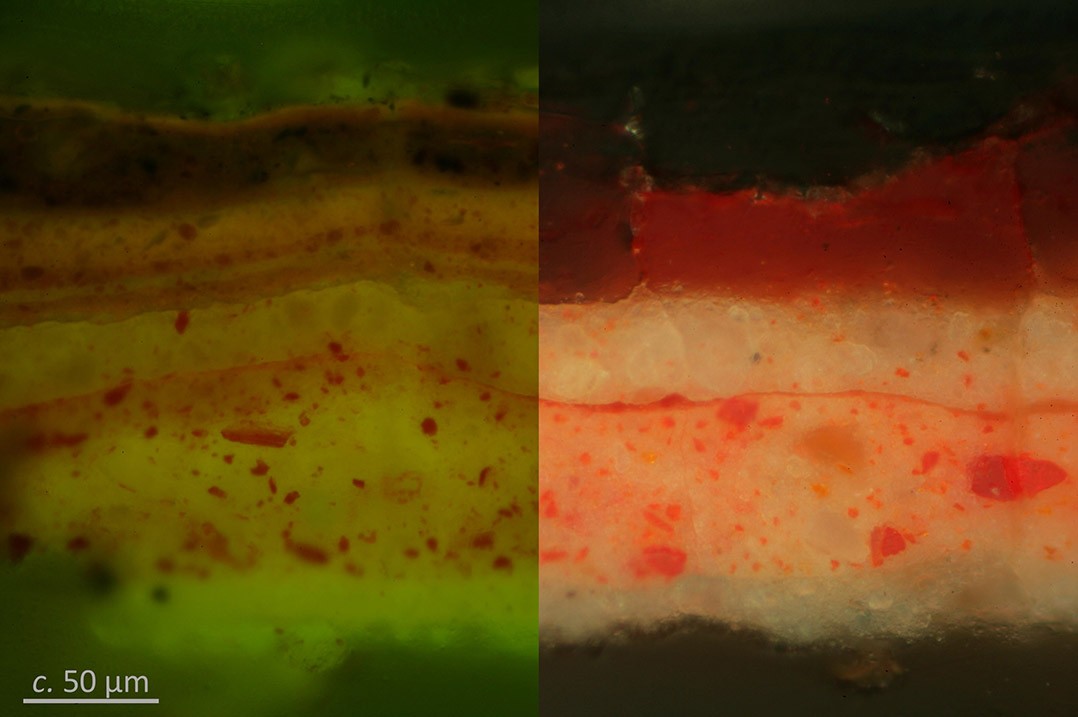Even when on view in a gallery full of striking works, Lorenzo Lotto’s half-length

Lorenzo Lotto, Saint Catherine, 1522, oil on panel, Samuel H. Kress Collection, 1939.1.117
In his Saint Catherine, Lotto achieved the visual effects of texture and shimmer using methods and materials that were a little unusual for painters in Italy during the 16th century. To create a brilliant, luminous effect, he exploited the translucency of oil paint made using organic red colorants, which we call red lakes.
Lotto’s complex painting method is revealed by a tiny cross-sectional sample taken from the bottom edge of the panel. The sample shows Lotto’s sequence of layering color and the pains he took in depicting the fabric for the dress.

Cross section of paint layers in Saint Catherine, under fluorescence (left) and visible light (right)
The right-hand side of this image shows the cross section in visible light. On a white preparatory layer, seen at the very bottom of the cross section, he put down pink paint—mixed from lead white, vermilion, and some red lake—then a thin glaze of red, then paler pink, and translucent deep-red paint. (The red layer is overlaid by a dark-brown layer to suggest a shadowed fold in the cloth, although it is difficult to discern against the black background in this image.)
The image on the left-hand side of the cross section, which was obtained using fluorescence microscopy, shows that what appears to the eye in visible light as a single thick layer of red paint is actually four or five thin layers. The difference in color of the fluorescence between layers strongly suggests that there are different pigments in alternating paint layers. The multiple layers of translucent paint glazed over opaque light-pink paint make this work appear to glow.
Red lake paints are very slow to dry, and that may be one reason why Lotto built up the depth of color using many thin layers. To hasten the slow drying, and perhaps to increase translucency, some artists added powdered glass to their red lake paints. We found that Lotto did something a little different: he added powdered quartz.
Pure quartz pebbles were the source of silica, a crucial raw material for Venice’s robust glassmaking industry. These quartz pebbles needed to be ground into powder—the glassmaker Antonio Neri, in his 1612 treatise on the craft, said it should be as fine as flour. The particles of quartz in Lotto’s paint are so small as to be invisible to the naked eye and cannot be seen in the magnified cross section shown here; they can only be found using scanning electron microscopy. Lotto returned to Venice, his birth city, off and on throughout his career, and he could have purchased finely powdered quartz from the sellers who traded there.
Lotto’s sophisticated technique and use of unconventional materials for painting are signs of creative ingenuity, a trait as prized in the Renaissance as it is today. Rediscovering artists’ innovations from the past can deepen our appreciation of achievements such as Saint Catherine and inspire new ideas to shine through in our own work.
Additional technical detail on the analysis of this painting is available in the article “Material Innovation and Artistic Invention: New Materials and New Colors in Renaissance Venetian Paintings.”

